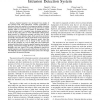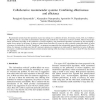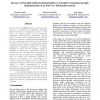730 search results - page 55 / 146 » Modeling trust in collaborative information systems |
HT
2005
ACM
14 years 2 months ago
2005
ACM
— Spatial hypertext was developed from studies of how humans deal with information overflow particularly in situations where data needed to be interpreted quickly. Intrusion det...
SEMCO
2008
IEEE
14 years 3 months ago
2008
IEEE
A huge amount of data and metadata emerges from Web 2.0 applications which have transformed the Web to a mass social interaction and collaboration medium. Collaborative Tagging Sy...
EUSFLAT
2003
13 years 10 months ago
2003
In recommender systems, user ratings of items are often represented in terms of linguistic labels such as “fair” or “very good”. We investigate the potential of fuzzy sets...
ESWA
2008
13 years 9 months ago
2008
Recommender systems base their operation on past user ratings over a collection of items, for instance, books, CDs, etc. Collaborative filtering (CF) is a successful recommendatio...
HICSS
2003
IEEE
14 years 2 months ago
2003
IEEE
Qureshi, et al. (2002) [1] presented a case study where they used a framework, the Intellectual Bandwidth Model to measure an organization’s ability to create value. The model c...



